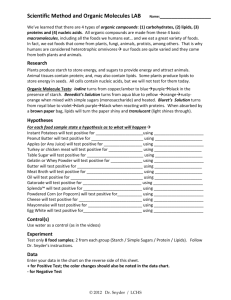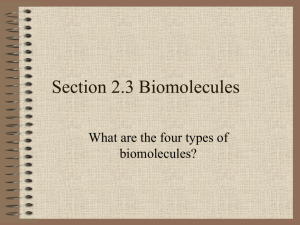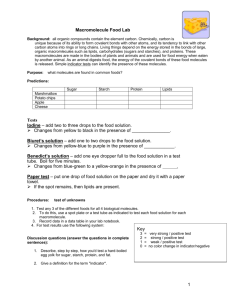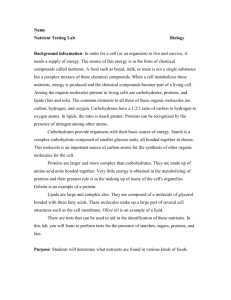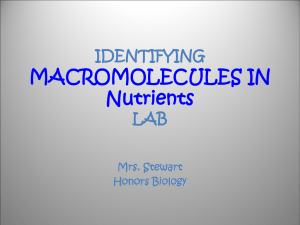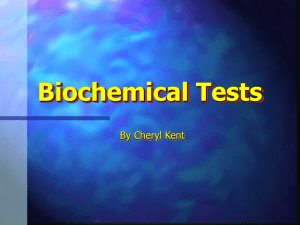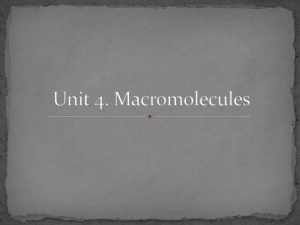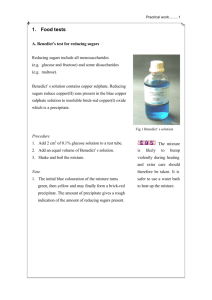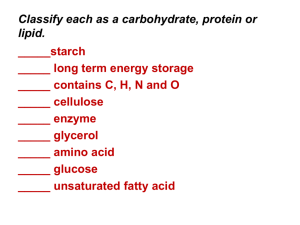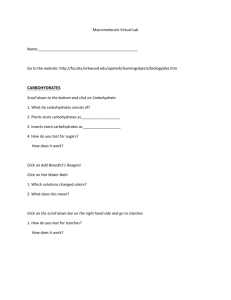Testing Macromolecules: Virtual Lab
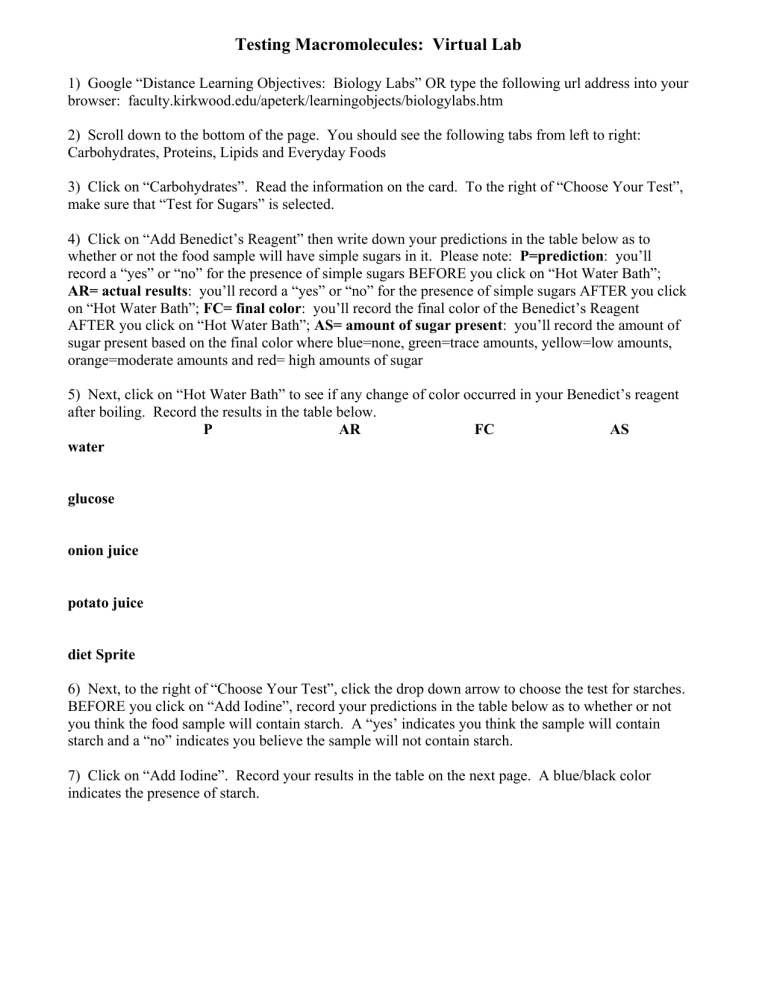
Testing Macromolecules: Virtual Lab
1) Google “Distance Learning Objectives: Biology Labs” OR type the following url address into your browser: faculty.kirkwood.edu/apeterk/learningobjects/biologylabs.htm
2) Scroll down to the bottom of the page. You should see the following tabs from left to right:
Carbohydrates, Proteins, Lipids and Everyday Foods
3) Click on “Carbohydrates”. Read the information on the card. To the right of “Choose Your Test”, make sure that “Test for Sugars” is selected.
4) Click on “Add Benedict’s Reagent” then write down your predictions in the table below as to whether or not the food sample will have simple sugars in it. Please note: P=prediction
: you’ll record a “yes” or “no” for the presence of simple sugars BEFORE you click on “Hot Water Bath”;
AR= actual results : you’ll record a “yes” or “no” for the presence of simple sugars AFTER you click on “Hot Water Bath”;
FC= final color
: you’ll record the final color of the Benedict’s Reagent
AFTER you click on “Hot Water Bath”;
AS= amount of sugar present
: you’ll record the amount of sugar present based on the final color where blue=none, green=trace amounts, yellow=low amounts, orange=moderate amounts and red= high amounts of sugar
5) Next, click on “Hot Water Bath” to see if any change of color occurred in your Benedict’s reagent after boiling. Record the results in the table below.
P AR FC AS water glucose onion juice potato juice diet Sprite
6) Next, to the right of “Choose Your Test”, click the drop down arrow to choose the test for starches.
BEFORE you click on “Add Iodine”, record your predictions in the table below as to whether or not you think the food sample will contain starch. A “yes’ indicates you think the sample will contain starch and a “no” indicates you believe the sample will not contain starch.
7) Click on “Add Iodine”. Record your results in the table on the next page. A blue/black color indicates the presence of starch.
Prediction water starch onion juice
Result potato juice diet Sprite
8) Next, click on the “Proteins” tab and read the information on the card. Make your predictions in the data table below about whether or not you think the food sample will contain protein. A “yes” indicates you think the food will contain protein and a “no” indicates you think the sample will not contain any protein.
9) Click on “Add Biuret Reagent” and record the results in the table below. A violet/purple color indicates proteins are present.
Prediction water
Final Color Result egg white chicken soup diet Sprite
10) Now it’s time to test for lipids. Click on the “Lipids” tab and the information on the page. Make predictions about which foods will have lipids present and record your predictions (“yes” or “no”) in the data table on the next page.
11) Click on “Add Sudan III” and record the results (“yes” or “no” based on final color) in the table below. The Sudan indicator will turn a bright orange if lipids are present in the food sample.
water cream coconut egg white
Prediction Final Color Result margarine
12) Finally, click on the “Everyday Foods” tab and read the information on the card. Choosing each of the four samples (gelatin, apple juice, Ritz cracker, skim milk), predict whether or not the four food samples will contain simple sugars, starch and protein by writing “yes” or “no” in the data below.
After you have made your predictions, you may click on the each of the tests to obtain results. Record those results in the data table below (P-prediction, AR=actual results, FC=final color).
apple juice cracker milk
Benedict’s P
gelatin
Benedict’s AR
Benedict’s FC
Sugar amt present
*********************************************************************************
Iodine P
Iodine AR
*********************************************************************************
Biuret P
Biuret AR
Discussion Questions
1) Were there any foods that tested positive for simple sugars, proteins and lipids? If so, what were they?
2) Were there any foods that tested positive for starch, proteins and lipids? If so, what were they?
2) Why was water used in all of the tests?
3) Give two examples of other foods that might contain protein.
5) What type of macromolecule are sugars and starches?
